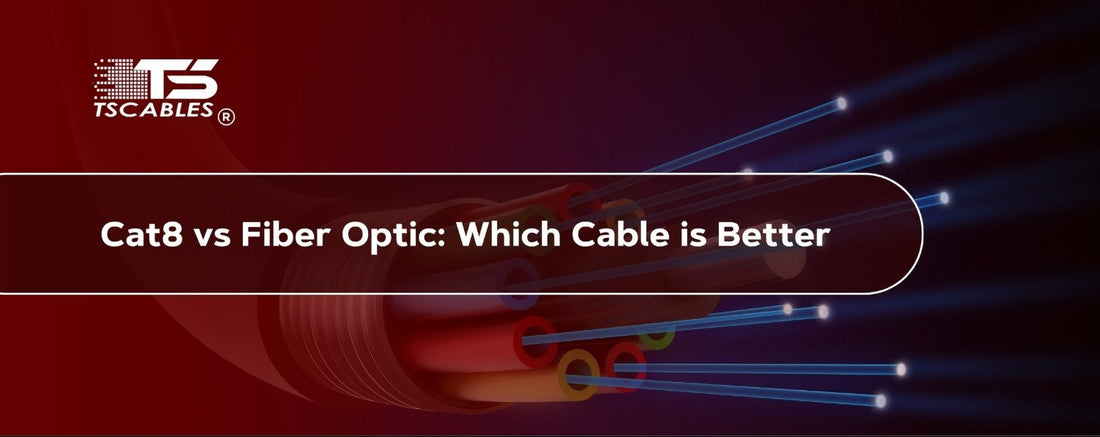Slow internet is frustrating, as lagging videos, dropped calls, and delays ruin the moment. Choosing the right cable makes a big difference. Two heavy hitters stand out: Cat8 Ethernet and fiber optic internet cables. They both offer speed, reliability, and performance. But they work in different ways.
This article breaks down everything you need to know about each. We’ll cover strengths, limits, and where each fits best. If you're upgrading your network or just curious, you're in the right place. Let’s keep it simple, straight, and useful without techy fluff. Here's how cable vs. fiber optic really compares.
What Are Cat 8 Ethernet Cables?
Cat 8 is short for Category 8, and it is a type of Ethernet cable made for ultra-fast data transfer. It's the latest in the Ethernet family and much faster than Cat 6 or Cat 7. These cables are designed to support up to 40 Gbps speeds and work well for short distances, usually up to 30 meters. That's your Cat 8 distance limit.
They're shielded to reduce outside interference and are perfect for connecting devices in high-speed setups like servers, modems, or gaming rigs. If you're asking, what is Cat8, think of it as a cable built for speed and low interference, especially good in tight, wired spaces where every second counts.
What Are Fiber Optic Cables?
Fiber optic cables use glass or plastic strands to send data as light pulses. That sounds like sci-fi, but it's common now in high-speed networks. The major win is the speed and distance it offers. These cables can carry signals over many kilometers without losing quality.
They're excellent in areas where interference is a problem. If you're wondering which network cable type is most susceptible to signal interference, it’s not fiber, since fiber is the best at avoiding it. Another question in your mind can be: how fast is a fiber optic cable? It can hit speeds of 100 Gbps or more, depending on the setup.
Cat8 vs. Fiber: Key Differences Between Them
Before choosing a cable, it's helpful to understand how these two differ in speed, setup, price, and more. Each has its role depending on what you need and where you plan to use it.
Speed and Bandwidth
Fiber optic wins in raw speed. It uses light, not electrical signals, which means it transmits data faster and over longer distances. That’s why it powers most major internet backbones.
Cat 8 is still blazing fast. It's one of the best Ethernet cables for streaming video with up to 40 Gbps speed, but only at shorter ranges. Great for connecting a few devices in close quarters.
Distance Limits
Here’s where fiber shines again. It works across miles without signal loss. Fiber is ideal if you need high performance across buildings or floors.
Cat 8 works best up to 30 meters. That is your Cat 8 distance limit. It's perfect for a room or two, but not for connecting entire offices or homes.
Setup and Cost
Cat 8 is plug-and-play. If you’ve used Ethernet before, this works the same. Fiber, on the other hand, usually needs professional installation and special tools.
In terms of cost, Cat 8 cables are cheaper than fiber when you're setting up a small or medium network. Fiber gets expensive if you're starting from scratch.
Interference
Interference is where fiber wins big. It’s immune to electromagnetic noise. So, if you’re in an area with lots of electronic noise, fiber is the smarter pick.
While Cat 8 is shielded, it's still an electrical cable. So, yes, it performs better than older Ethernet types, but it's still more vulnerable than fiber.
Use Cases
Cat 8 fits short, high-speed connections, such as home networks, server rooms, or even for people gaming in the basement. On the other hand, Fiber fits data centers, large offices, or buildings far apart.
When To Use Cat8 vs. Fiber Optic Cables?
Picking the right cable depends on your goals. Not every setup needs top-tier tech. Some just need solid, steady internet without extra fuss. Below, we’ve sorted where each type shines.
Best Environments for Cat 8 Cables
Use Cat 8 in places that need fast speeds over short distances. Think gaming setups, home theaters, or connecting your modem to a high-speed router. It's especially useful if you stream 4K videos and need the best Ethernet cable for streaming video without lag.
It also works well in server rooms where devices are stacked close together. Easy to install, budget-friendly, and gets the job done without needing special tools.
Best Environments for Fiber Optic Cables
Fiber shines in larger spaces. Offices, schools, or factories where data needs to travel far and fast. Since it avoids signal interference, it's perfect near heavy machinery or electronics.
You’ll also want fiber if your provider offers optical internet cable as part of your internet package. Fiber internet is blazing fast, and pairing it with fiber inside your building keeps that speed consistent.
Final Thoughts
Both cables serve a purpose. Cat 8 delivers speed without the high cost. Fiber offers unmatched distance and clean data transfer. Your needs decide the winner based on budget, space, and speed expectations all play a part.
Upgrade your network with top-tier cables from TS Cables that are built for speed, stability, and smooth connections.
FAQs
Is Cat 8 good for home use?
Yes, especially if you stream or game a lot. It's fast and easy to install.
Can fiber optic cables break easily?
They’re strong but need careful handling. Bending or stepping on them can cause damage.
Does fiber need special routers?
Often, yes. You’ll need a router that supports fiber or a converter box.
How far can Cat 8 cables run?
The Cat 8 distance limit is about 30 meters (around 100 feet).
Which is better for long distances: Cat 8 or fiber?
Fiber is better as it stays strong over miles without signal loss.






